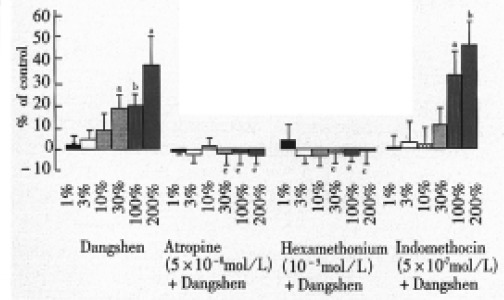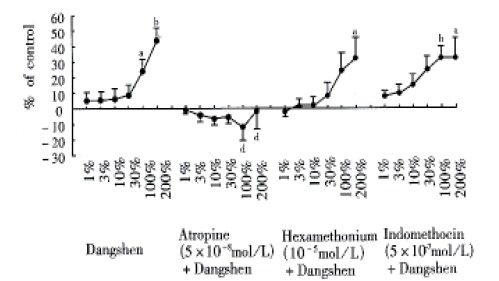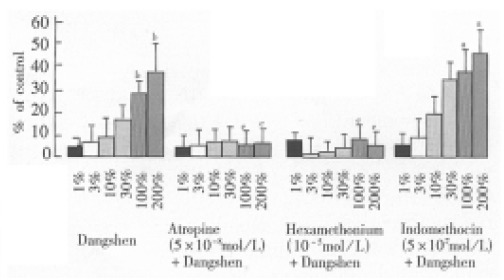Abstract
AIM: To study the effects of Dangshen [dried root of Codonopsis Pilosula (Franch) Nannf] on contractile activity of isolated gastric muscle strips in rats and its possible mechanism involved.
METHODS: Each isolated gastric muscle strip was put in a tissue chamber containing 5 mL Krebs solution, constantly warmed by water jacket at 37 °C and supplied with a mixed gas of 95% O2 and 5% CO2. After incubating for 1 h with 1g tension, Dangshen of varied concentration was added cumulatively in the tissue chamber at intervals of 2 min. The isometrical response was measured on ink-writing recorders.
RESULTS: Dangshen dose dependence increased the resting tension of longitudinal muscle (LM) of fundus (r = 0.96, P < 0.01), the mean contractile amplitude of circular muscle (CM) of the stomach body (r = 0.87,P < 0.05) and CM of antrum (r = 0.98, P < 0.01), and the motility index CM of pylorus (r = 0.87, P < 0.05). Atropine (5 × 10-8 mol/L) or Hexamethonium (10-5 mol/L) or Indomethacin (5 × 10-7 mol/L) was given 2 min before the administration of Dangshen, it did not abolish its dose related manner. Atropine apparently reduced the increasing action of 10% and 30% Dangshen on the resting tesion of LM of fundus (P < 0.05), 30%, 100% and 200% Dangshen on bodied strips (P < 0.05), 100% and 200% Dangshen on antral strips (P < 0.05).Hexamethonium reduced the increasing action of 10% and 30% Dangshen on the resting tesion of LM of fundus (P < 0.05 and P < 0.05), 30%, 100% and 200% Dangshen on bodied strips (P < 0.05), and 100% and 200% Dangshen on pyloric strips (P < 0.05). Indomethacin inhibited the effect of 10% Dangshen on the resting tesion of LM of fundus (P < 0.05), but did not affect the exciting action of Dangshen on strips of body, antrum and pylorus.
CONCLUSION: The results showed that Dangshen possessed exciting action on the isolated gastric smooth muscle strips of the rat. The exciting action of Dangshen was partially mediated via cholinergic M and N receptors.
Keywords: Dangshen; stomach; muscle, smooth; muscle contraction; receptors, cholinergic; rats
INTRODUCTION
Recently, close attention has been paid to the Chinese drugs that affect the alimentary tract and are used to treat gastrointestinal motility disorders. Dangshen [Codonopsis Pilosula (Franch) Nannf.] is a main Chinese drug to treat spleen and stomach disorders. Previous studies had shown that Dangshen regulated gastric basic electrical rhythm disorder on stress condition and inhibited gastric motility on acute gastric ulcer in rats[1]. The effect of Dangshen on isolated gastric muscle strips in rats has not been published, so we have studied the action of Dangshen on gastric smooth muscle in rats and the possible mechanism involved.
MATERIALS AND METHODS
Dangshen was ground into coarse powder, boiled in distilled water, filtered and made 100% extract solution. The 100% Dangshen extract solution was dispensed in the concentration of 1%, 2%, 7%, 20%, 70% and 100% respectively (The drug was made and identified by Gansu Institute for Drug Control).
Wistar rats, weighing 250 g-300 g were fasted with free access to water for 24 h. Then they were hit to lose consciousness and the whole stomach was removed. The stomach was opened along greater curvature and four strips (8 mm × 2 mm) were cut, parallel to either the longitudinal or circular fibers and named longitudinal muscle (LM) of fundus, circular muscle (CM) of body, antrum and pylorus[2]. Each strip with the mucosa removed was suspended in a tissue chamber containing 5 mL Krebes solution, constantly warmed by circulating water jacked at 37 °C and supplied with a mixed gas of 95% O2 and 5% CO2. One end of the strip was fixed to a hook on the bottom of the chamber while the other end was connected by a thread to an external isometric force transducer (JZ-BK, BK) at the top. Preparation were subjected to 1 g load tension and washed with 5 mL Krebs solution every 20 min. The contractions of gastric strips in 4 tissue chambers were simultaneously recorded on ink-writing recorders (LMS-ZB, Cheng-Du)[3]. After incubating for 1 h, Dangshen (1%, 2%, 7%, 20%, 70% and 100%) were added in a 5 mL bath continuously at intervals of 2 min, so that the cumulative concentration reached 1%, 3%, 10%, 30%, 100% and 200%. Atropine (5 × 10-8 mol/L) or Hexamethonium (10-5 mol/L) or Indomethacin (5 × 10-7 mol/L) was given 2 min before administration of Dangshen.
We measured the resting tension of LM of fundus, the mean contractile amplitude of CM of body and antrum and the motility index [MI = ∑ (amplitude × duration)] of CM of pylorus. Frequency of contraction was calculated by counting the contraction waves. The results were demonstrated by the increasing percentage (%) of the control spontaneous contraction ( -x ± sx). The data were analyzed with the Student’s t test. The correlation coefficients were calculated, and value of P < 0.05 was considered to be significant.
RESULTS
Effect of Dangshen on spontaneous contraction of fundic strips
Dangshen dose dependence increased the resting tension of LM of fundus (r = 0.96, P < 0.01). Atropine (5 × 10-8 mol/L) or Hexame thonium (10-5 mol/L) or Indomethacin (5 × 10-7 mol/L) did not affect its action in dose related manner (r = 0.99, P < 0.01). Atropine or hexamethonium reduced the effect of 10% and 30% Dangshen (P < 0.05), while Indomethacin inhibited the effect of 10% Dangshen on the resting tension of LM of fundus significantly (P < 0.05, Table 1).
Table 1.
Effect of Dangshen and antagonists plus Dangshen on the resting tension of the fundus in rats
| 1% | 3% | 10% | 30% | 100% | 200% | |
| Dangshen | 0 | 5.4 ± 3.3 | 38.8 ± 6.9b | 75.8 ± 11.9b | 153.8 ± 17.9b | 163.3 ± 20.0b |
| (n = 12) | (n = 12) | (n = 12) | (n = 12) | (n = 12) | (n = 12) | |
| Atropine (5 × 10-8 mol/L) + Dangshen | 1.0 ± 0.7 | 4.3 ± 2.2 | 18.0 ± 4.8bc | 38.0 ± 10.5bc | 120.3 ± 21.9b | 132.3 ± 23.0b |
| (n = 15) | (n = 15) | (n = 15) | (n = 15) | (n = 15) | (n = 15) | |
| Hexamethonium(10-5 mol) + Dangshen | -1.8 ± 1.3 | -1.5 ± 1.8 | 14.1 ± 5.7ad | 42.6 ± 9.3bc | 143.0 ± 21.7b | 179.4 ± 28.8b |
| (n = 17) | (n = 17) | (n = 17) | (n = 17) | (n = 17) | (n = 17) | |
| Indomethacin(5 × 10-7 mol/L) + Dangshen | 0 | 0 | 14.3 ± 5.4ac | 42.1 ± 14.9a | 116.4 ± 24.1b | 157.8 ± 29.9b |
| (n = 14) | (n = 14) | (n = 14) | (n = 14) | (n = 14) | (n = 14) |
P < 0.05,
P < 0.01 vs control;
P < 0.05,
P < 0.01 vs Dangshen on the same concentration; 0, no effect; -x ± sx (%) increase.
Effect of Dangshen on the spontaneous contraction of bodied strips
Dangshen dose dependence increased the mean contractile amplitude of CM of body (1.7% ± 3.9%, 4.2% ± 3.3%, 7.5% ± 6.8%, 15.7% ± 5.4%, 16.6% ± 4. 9% and 32.2% ± 11.8%, respectively, r = 0.87, P < 0.05). Atropine (5 × 10-8 mol/L) or hexamethonium (10-5 mol/L) apparently reduced the increasing action of 30%, 100% and 200% Dangshen (-1.5% ± 4.3%, -1.5% ± 5.3%, -2.3% ± 3.9%, and -1.9% ± 3.8%, -2.4% ± 3.1%, -0.7% ± 5.8% respectively, P < 0.05), while Indomethacin (5 × 10-7mol/L) did not apparently affect the increasing action of Dangshen (Figure 1). All drugs did not affect the contractile frequency of bodied strips significantly.
Figure 1.

Effect of Dangshen and antagonists plus Dangshen on the mean contractile amplitude of bodied strips in rats. aP < 0.05, bP < 0.01 vs control; cP < 0.05 vs Dangshen in the same concentration; -x ± sx (%) increase.
Effect of Dangshen on the spontaneous contraction of antral strips
Dangshen dose dependence increased the mean contractile amplitude of CM of antrum (5.4% ± 5. 5%, 5.6% ± 5.1%, 6.3% ± 6.1%, 8.6% ± 6.2%, 23.9% ± 7.5% and 43.8% ± 7.5%, respectively, r = 0.98, P < 0.01). Atropine (5 × 10-8 mol/L) significantly reduced the increasing action of 100% and 200% Dangshen (-12.5% ± 8.6% and -2.0% ± 11.4%, P < 0.05), while Hexamethonium (10-5 mol/L) or Indomethacin (5 × 10-7 mol/L) didn’t affect the increasing action of Dangshen (Figure 2). All drugs did not significantly affect the contractile frequency of antral strips.
Figure 2.

Effect of Dangshen and antagonists plus Dangshen on the mean contractile amplitude of antral strips in rats. aP < 0.05, bP < 0.01 vs control; dP < 0.01 vs Dangshen on same concentration; -x ± sx (%) increase.
Effect of Dangshen on the spontaneous contraction of pyloric strips
Dangshen dose dependence increased the motility index of CM of pylorus (5.1% ± 9.7%, 7.4% ± 5.0%, 8.5% ± 7.1%, 14.4% ± 6.5%, 28.8% ± 4.1% and 38.8% ± 10.6%, respectively, r = 0.87, P < 0.05). Atropine (5 × 10-8 mol/L) or hexamethonium (10-5 mol/L) significantly reduced the increasing action 100% and 200% Dangshen (5.3% ± 9.3% and 5.7% ± 7.7%; 7.0% ± 6.9% and 3.4% ± 7.9%, respectively, P < 0.05). Indomethacin (5 × 10-7 mol/L) didn’t affect the increasing action of Dangshen (Figure 3). All drugs did not affect the contractile frequency of pyloric strips significantly.
Figure 3.

Effect of Dangshen and antagonists plus Dangshen on the mean contractile amplitude of pyloric strips in rats. aP < 0.05, aP < 0.05, bP < 0.01 vs control; dP < 0.01 vs Dangshen on same concentration; -x ± sx (%) increase.
DISCUSSION
Pi-Wei (spleen-stomach) is a functional conception that means alimentary-system involving the other system in traditional Chinese medicine. Dangshen is the main Chinese drug to maintain Pi-Wei and posses the effect in “Bu-Zhong-Yi-Qi” and “He-Wei-Sheng-Jing”.
It was reported that Dangshen might react experiment gastric ulcer and lesion of stomach mucosa and inhibit gastric acid secretion in rats. Dangshen had the regulating action on gastrointestinal motility, influenced gastric basic electrical rhythm disorder, and partly reduced the increasing action of gastric motility and emptying on stress condition of the rats[4]. It also had the inhibiting and exciting effects on isolated ileum segment in guinea pigs[5]. Our previous experiments have shown that BU-QI had the exciting action on isolated gastric strips[6]. Our results indicated that Dangshen dose dependence increased the resting tension of LM of fundus, the mean contractile amplitude of CM of body and antrum, and the motility index of CM of pylorus. This may support that on clinic Dangshen has the gastroprokinetic effect of treating “Pi-Wei-Xu-Han and Shi-Yu-Bu-Zhen”.
All smooth muscle is involuntary and the nerves in the gastrointestinal tract are controlled both by extrinsic autonomatic nerves and by intrinsic neural plexus. These plexus extensively interact with each other and are independently extrinsic neural control. Many of the local neurogenic reflexes in the gut occur in these plexuses, and play an important role in regulating the gastrointestinal motility. Cholinergic N-receptors exist on the membrane of the nerve ganglion cell of cholinergic M-receptors on the membrane of gastric smooth muscles. Our experiment showed that Atropine partly blocked the increased action of Dangshen on the isolated strips of fundus, body, antrum and pylorus in rats. Hexamethonium had the same effect on fundus, body of the stomach and pylorus. This is an evidence that effect of Dangshen was partly mediated via cholinergic M and N receptors. Prostaglandin protected gastric mucosal cells and regulated gastric motility[7]. Indomethocin inhibited endogenous prostaglandin synthesis. In our experiment, Indomethocin did not influence the action of Dangshen on the rat stomach strips except 10% Dangshen on fundic strips.
It is very interesting to study traditional Chinese medicine and to select different drugs for treating the gastrokinetic disorder in patients.
Footnotes
Project supported by the Natural Scientific Foundation of Gansu Province, No.ZR-94-085.
References
- 1.Zhou R, Zhang L. Search for a pharmacological role of Dangshen in alimen-tary system. J Beijing Tradit Chin Med. 1991;14(5):47–48. [Google Scholar]
- 2.Qu SY, Song CW, Lee KY, Chey WY. Action of secretion and/or cholecystoki-nin on gastric smooth muscle in rats. Gastroenterology. 1992;104(2-4):A567. [Google Scholar]
- 3.Qu SY, Zheng TZ, Li W. Comparative study of ranitidine and cimitidine on contractile activity of isolated gastric muscle strips in rats. China Natl J New Gastroenterol. 1997;5(2):75–76. [Google Scholar]
- 4.Hou JY, Jiang ZW, He ZZ. Effect of Dangshen on gastric electricity, motility and emptying on rats of stress gastric ulcer. Chin J of Integrated Tradit and Western Med. 1989;9(1):31–32. [PubMed] [Google Scholar]
- 5.Wang YZ, Wang M, Tian SF. Influence of radix codonopsis pilosulae on isolated ileac movement of guinea pig. Jiangsu J Tradit Chin Med. 1983;4(3):58–59. [Google Scholar]
- 6.Zheng TZ, Li W, Qu SY. Action Tradit Chin Med BUQI on contractile of isolated gastric muscle strips in rats. Caps News Communication. 1996;15(supp. 4):20–21. [Google Scholar]
- 7.Sanders KM. Role of prostaglandins in regulating gastric motility. Am J Physiol. 1984;247:G117–G126. doi: 10.1152/ajpgi.1984.247.2.G117. [DOI] [PubMed] [Google Scholar]


